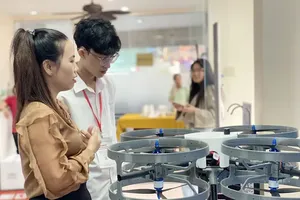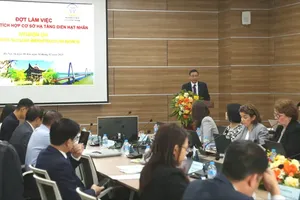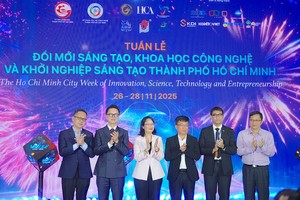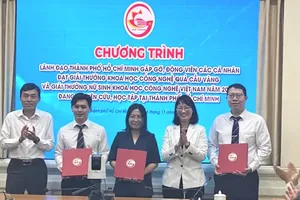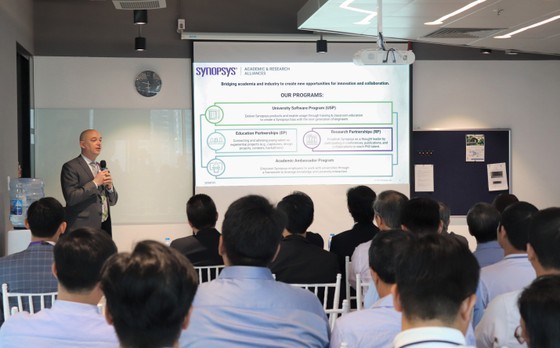 |
A representative of Synopsys introduces the IC training program at SHTP IC Design Center |
Experts in the microchip industry said that in the microelectronics industry, a semiconductor fabrication plant requires large capital and high risk, so it is not an option for Vietnamese enterprises in the short term.
At the end of March, the Management Board of Ho Chi Minh City Hi-Tech Park (SHTP) and the Sun Electronics Group Joint Stock Company put into operation the International Electronic Training Center (IETC) at the SHTP Training Center.
The center provides training programs according to IPC (International Process Control) standards, which are standards for the management and operation of electronic manufacturing plants that are widely applied by world technology corporations and Product Design standards according to international standards and regulations.
Learners at the non-profit IETC Center including engineers working in enterprises, recent graduates from universities and entrepreneurs starting in the field of electronics and microchips will be taught directly by Vietnamese experts who have worked for many years in large electronic corporations in Silicon Valley (USA).
Previously, the first 24 lecturers were awarded certificates of completion of the IC design trainer training course organized by SHTP Chip Design Center (SCDC) for the construction and development of the chip industry of Ho Chi Minh City.
In particular, participating lecturers have access to the entire library and exclusive teaching materials of Synopsys, from which they can build a practical IC design curriculum for future training.
SCDC was established at the end of 2022 under a cooperation agreement between SHTP Management Board and the world's leading chip design tool supplier Synopsys (USA).
Mr. Robert Li, Sales Vice President of Synopsys, said that SHTP is the innovation center of Vietnam's high-tech industry. Synopsys will support SHTP in establishing a chip design center with Synopsys's cutting-edge technology and university support program initiatives."
Mr. Robert Li disclosed that the current biggest challenge of the chip industry is the lack of human resources, while Vietnam has this strength and the cost is still low compared to other countries in the region such as Singapore and Malaysia. SCDC is an important infrastructure to train human resources in the field of IC design.
Mr. Nguyen Anh Thi, Head of the SHTP Management Board, said that the establishment of two important centers SCDC and IETC will form a complete training ecosystem at SHTP which will directly contribute to improving the quality of human resources in the electronics and microchip industries. This is also a very important preparation step in promoting investment in strategically located industries such as electronics and semiconductors in 2023 and the following years. This step-by-step reinforces the goal to turn Vietnam into the semiconductor IC design center of the region and the world.
According to data from SHTP, Ho Chi Minh City is home to more than 80 percent of businesses and human resources in the field of IC design in Vietnam. Particularly at SHTP, in addition to enterprises specializing in IC design such as SNST Finger&ADT Technology (Korea), Microchip (USA), Intel (USA), and OIEC (Vietnam) create the base system for the development of the semiconductor industry.
According to experts, the semiconductor industry is the core of the electronics industry. In 2022, Vietnam's electronics industry exports are worth more than US$120 billion, but it is still modest compared to other countries in the region. Therefore, it is necessary to develop more enterprises, experts and engineers capable of occupying the domestic market.
According to Professor Dang Luong Mo, a leading expert in the field of semiconductor ICs, Vietnam needs to focus on IC design and IC application (ie the electronics industry) and the design stage including product design and chip design.
He said in addition to important domestic human resources, the government should invite Vietnamese people who are working in developed countries, especially in Silicon Valley in the US to return to Vietnam. Additionally, the government needs to have better policies to take advantage of these talents for technology transfer, training and human resource development in the country.

